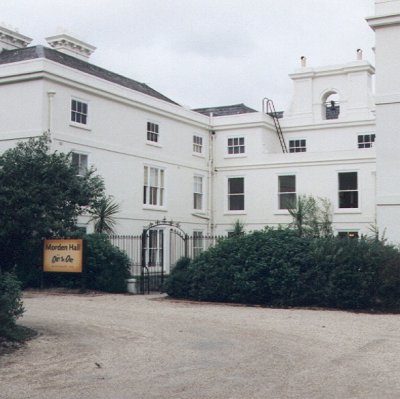
Like us on Facebook
PLACE NAMES


 
|
|
Morden
|

|
|
|
Morden might get its name either from the British language words Mawr (great or large) and Dun (a fort), or possibly "The Town on the Moor".
Human activity in Morden dates back to the Iron age period when Celtic tribes are known to have occupied areas around Wimbledon, but the first significant development in Morden was the construction of the Roman road called Stane Street from Chichester to London.
The route of Stane Street through Morden followed the current A24, London Road up Stonecot Hill from the south west crossing Morden Park to the west of the current dual carriageway road and passing through the pitch and putt golf course and the grounds of St Lawrence's Church. The road then descended the other side of the hill towards the town centre passing west of the Underground station and crossing the north corner of Morden Hall Park heading in the direction of Colliers Wood and Tooting. Small Roman artifacts, mainly coins and pottery, have been found at various locations within the area although there is no evidence of any settlement.
Ethelstan the Etheling, son of Ethelred the Unready, left "land at Mordune" to the abbey of Christ and St. Peter in his will of 1015, which became the site of the first Saxon parish church of St Lawrence.
In 1086, the Domesday Book recorded the manor as Mordone, part of Wallington Hundred. It was held by Westminster Abbey and its assets were: 3 hides; 1 mill worth £2 and 7 ploughs. It rendered £15. in total. Fourteen people were recorded as living in the area.
Despite London's suburban expansion, a little of the earlier rural nature of Morden has survived; for instance several grand period buildings remain, especially within Morden's parks. The area retains a good provision of parks and green spaces, many of them created from former country estates. The 125 acre Morden Hall Park is of particular note and is run by the National Trust (see below). Its main entrance is only a quarter-of-a-mile from Morden Underground Station.
The largest building in the town centre is Crown House, sixties-built and 14 storeys tall; designed in 1959 by A. Green ARIBA and built between 1960 and 1962. The concave frontage of the building lends it some distinction, as does the "chessboard" style juxtaposition of its light and dark facade features. It incorporated the Crown public house, on which site part of the building covered. The building is home to Merton Council's Civic Centre and a large adjoining library.
At around the same time, Morden Underground Station, originally a single storey building, with shops, had three-storey office accommodation incorporated above it.
A further office building with a large supermarket (now a Sainsbury's) at ground-floor level was built in the eighties at the other end of the town centre.
The cinema and adjoining garage were demolished and replaced by shops some years ago.
Morden plays host to a number of buildings and parks worthy of note including:
- The Bait'ul Futuh Mosque, the largest mosque in Western Europe, built by the Ahmadiyya Muslim Community. Completed in 2003 at a cost of approximately £5.5 million, the mosque covers an area of 5.2 acres and the full complex can accommodate up to 10,000 worshippers. It was voted one of the top 50 buildings in the world by Spectator Magazine. It is located next to Morden South railway station and approximately 700 yards from Morden Underground station;
- Morden Hall Park is a key feature of the Morden area with large, period buildings located within its boundaries. It is a National Trust park, and is located on the banks of the River Wandle, near the town centre and few hundred yards from Morden Underground station. It covers over 50ha (125 acres) of parkland with the River Wandle meandering through it spanned by numerous foot-bridges. The estate contains a number of historic buildings including Morden Hall itself, Morden Cottage, an old Snuff Mill, and many old farm buildings, some of which are now a garden centre and a city farm. The rose garden has over 2000 roses. The estate land was originally owned by Westminster Abbey. There is evidence of an earlier manor-house, but Morden Hall dates back to the 1770s and contains a variety of natural landscapes, including the parkland of the "Deer Park", meadow and marshland;
- Morden Park, another park containing a period building of note. The park includes land that previously formed the grounds of Morden Park House, a small 18th-century country estate. The Georgian country house was built at the top of the hill in the 1770s for merchant and distiller John Ewart with attached landscaped gardens;
- St Lawrence Church, Morden. St Lawrence Church is the Church of England parish church for Morden. The building is Grade I listed, and located on London Road, at the highest point of Morden, overlooking Morden Park. Located on the Garth family estate, the current church was built in the 1630s in the Protestant style, and replaced an earlier wooden one from the Saxon period;
- Morden Baptist Church. The Church stands with the main entrance facing up Crown Lane on the Morden one way system. In 1990 a very substantial building scheme was undertaken to provide the current improved facilities, including an enclosed concourse, new offices and a sound-proofed cresh with a view into the main church.
|
 Feel free to Email me any additions or corrections Feel free to Email me any additions or corrections
LINKS AVAILABLE TO YOUR SITE
| |





